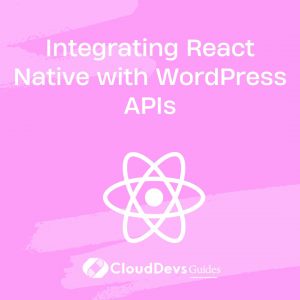Integrating React Native with WordPress APIs
In the ever-evolving landscape of app development, React Native has emerged as a powerful framework for building cross-platform mobile applications. Its ability to streamline the development process and deliver high-performance applications has made it a favorite among developers. In this guide, we’ll explore how to integrate React Native with WordPress APIs, leveraging the power of both platforms to create dynamic and engaging mobile experiences.
Why Integrate React Native with WordPress?
WordPress is the world’s most popular content management system, powering millions of websites across various domains. By integrating React Native with WordPress APIs, developers can leverage the vast array of content stored in WordPress to create mobile applications with rich and dynamic features. This integration opens up endless possibilities for developers, enabling them to build mobile apps that seamlessly sync with WordPress-powered websites.
Getting Started
Before diving into the integration process, it’s essential to have a basic understanding of React Native and WordPress APIs. If you’re new to React Native, you can refer to the official documentation and tutorials to get started. Similarly, familiarize yourself with the WordPress REST API, which provides access to WordPress content and data in a structured format.
Integration Steps
1. Set Up a WordPress REST API Endpoint
The first step is to enable the REST API on your WordPress website. This can be done by installing and activating the WP REST API plugin. Once activated, you can access WordPress data through API endpoints.
2. Authenticate Requests
To ensure secure communication between your React Native app and the WordPress website, it’s crucial to implement authentication mechanisms. WordPress supports various authentication methods, including OAuth, JWT, and cookie-based authentication. Choose the method that best suits your application’s requirements and implement it accordingly.
3. Fetch Data from WordPress
With the REST API enabled and authentication set up, you can start fetching data from your WordPress website. Use fetch or axios in your React Native application to send HTTP requests to the WordPress API endpoints and retrieve the desired content.
4. Display WordPress Content in React Native
Once you’ve fetched data from WordPress, you can display it in your React Native app using components such as FlatList, ScrollView, or custom UI components. Format the retrieved data as per your app’s design requirements and render it on the screen.
5. Handle User Interactions
In addition to displaying WordPress content, you can also implement functionality for user interactions such as liking posts, commenting, or sharing content. Capture user actions in your React Native app and send corresponding requests to the WordPress API endpoints to perform the desired actions on the WordPress website.
Example Applications
To further illustrate the integration of React Native with WordPress APIs, let’s look at a few example applications:
1. News Aggregator App
Build a mobile app that fetches articles from a WordPress-powered news website and displays them in a scrollable list. Users can read articles, save them for offline reading, and share them with friends.
2. E-commerce App
Create a shopping app that connects to a WordPress WooCommerce store via the REST API. Users can browse products, add them to their cart, and make purchases seamlessly from within the app.
3. Blog Reader App
Develop an app that syncs with a WordPress blog and allows users to read and bookmark blog posts for later viewing. Implement features such as search, categories, and tags to enhance the user experience.
Conclusion
Integrating React Native with WordPress APIs offers developers a powerful toolkit for building feature-rich mobile applications. By leveraging the flexibility and extensibility of both platforms, developers can create dynamic and engaging experiences for users. Whether you’re building a news app, e-commerce platform, or blog reader, the combination of React Native and WordPress opens up a world of possibilities for mobile app development.
External Resources
In conclusion, integrating React Native with WordPress APIs empowers developers to create mobile applications that seamlessly connect with WordPress-powered websites, offering users a cohesive and immersive experience across platforms. So why wait? Dive into the world of React Native and WordPress integration and unlock the full potential of mobile app development.
Table of Contents









